Former Heisman Trophy winning quarterback Tim Tebow was able to play football for his local public school in Florida while being homeschooled.
Tebow, the Heisman winner, two-time national champion, and first round draft pick, made international news most recently when he proposed to Demi-Leigh Nel-Peters, a former Miss Universe.
Florida is one of about three dozen states that allow homeschool students to play sports for their local high school. Some states have enacted this policy through legislation. In other instances, state high school athletic associations have put this policy in place. The Alabama High School Athletic Association recently made such a change.
Though the policies may vary, the intention is similar: just because you are homeschooled does not mean you can’t play sports for your local high school that your taxes are funding.
Every neighboring state permits homeschool students to play high school sports. Mississippi stands out as the only state that does not.
Over the past several years, including this year already, various bills have been introduced in the legislature to make this change. Only once has such a bill made it out of committee and it was killed on the Senate floor thanks in large part to an odd coalition of opponents that included the Home School Legal Defense Association (HSLDA). HSLDA normally take a neutral position on “Tebow bills,” but believed that particular legislation threatened the academic freedom of all homeschoolers.
Homeschoolers in Mississippi enjoy a high level of academic freedom. Something that upsets many people in both parties. In an effort to preserve what homeschoolers have already “won” in Mississippi, it doesn’t look like any changes will be made to the homeschooling code sections any time soon.
At least not until a Tim Tebow comes on the scene in Mississippi.
School district consolidation in Mississippi can offer both efficiency and savings to taxpayers. It is also one of the trickiest, and most sensitive issues, to local residents, and local lawmakers.
Over the past five years, the state legislature has led on the issue with 10 separate consolidation bills impacting 21 different school districts. By 2021, the state will have 13 fewer school districts than in 2014.
The formula behind the consolidation has largely been to merge two, or in some cases three, districts that are in the same county and are both failing, or, at best, struggling. The consolidations have included:
- Consolidating North Bolivar School District and Mound Bayou School District into the North Bolivar Consolidated School District (2014);
- Consolidating Benoit School District, West Bolivar School District, and Shaw School District into the West Bolivar School District (2014);
- Consolidating Sunflower County School District, Drew School District, and Indianola School District into the Sunflower County Consolidated School District (2014);
- Consolidating Oktibbeha County School District and Starkville School District into the Starkville Oktibbeha Consolidated School District (2015);
- Consolidating the Clay County School District and West Point School District into the West Point Consolidated School District (2015);
- Consolidating the Winona School District and the Montgomery County School District into the Winona Montgomery Consolidated School District (2018);
- Consolidating the Durant School District and the Holmes County School District into the Holmes County Consolidated School District (2018);
- Consolidating the Greenwood School District and the Leflore County School District into the Greenwood Leflore School District (2019);
- Dissolving the Lumberton School District into the Lamar County School District (2019);
- Consolidating Chickasaw County School District and Houston School District into the Chickasaw County School District (2021).
Still, school districts in Mississippi serve a lower number of students, on average, than every other state in the Southeast, save for Arkansas. What does that mean? We are spending money on additional salaries, pensions, benefits, buildings, etc. that other states are not. This means less money in the classrooms.
Mississippi’s school districts are inefficient compared to other Southern states
| State | Total enrollment | Total school districts | Students per district |
| Florida | 2,721,459 | 67 | 40,619 |
| North Carolina | 1,443,163 | 115 | 12,549 |
| Virginia | 1,279,544 | 135 | 9,478 |
| Georgia | 1,744,240 | 199 | 8,765 |
| South Carolina | 718,322 | 82 | 8,760 |
| Tennessee | 960,704 | 142 | 6,766 |
| Louisiana | 720,458 | 126 | 5,718 |
| Alabama | 733,951 | 136 | 5,397 |
| West Virginia | 281,439 | 55 | 5,117 |
| Kentucky | 685,176 | 173 | 3,961 |
| Mississippi | 492,279 | 151* | 3,260 |
| Arkansas | 475,782 | 254 | 1,873 |
Source: National Education Association, “Rankings & Estimates 2014-2015”
The average district size among the 12 states was 9,467, almost three times the size of the average district in Mississippi. For Mississippi to be in line with that average, the state would need to see a reduction to 52 school districts, eliminating almost two-thirds of the districts in the state.
Florida is the biggest outlier in this group. Removing the Sunshine State from the mix would drop the average district size to 6,513. Even doing that, Mississippi would still need to drop to 75 districts to be at the average. That is a reduction of almost 50 percent.
Among neighboring states, if school districts in Mississippi were to serve the same number of students as school districts in Alabama, Mississippi would need to experience a reduction to 91 districts. To mirror Louisiana, Mississippi would need a reduction to 86 districts. And to match the same number of students per district as Tennessee, Mississippi would need a reduction to 73 districts. Either of these changes would represent a decrease of 40 to 50 percent of the districts in the state.
Additionally, the districts in Mississippi are largely unbalanced. Half of all public school students in the state attend school in one of just 28 school districts. Yet, 63 districts have less than 2,000 students and educate just 16 percent of students.
There is not a magic size for a district. There are poor performing large districts, starting with Jackson Public Schools, just as there are high-performing small districts. But this inefficient distribution of students, which results in excessive bureaucracy, costs taxpayers money and prevents dollars from making it to the classroom.
While there is overwhelming local pressure to oppose consolidation, the legislature should continue with the process of reducing the number of school districts in Mississippi.
* This data was released before Mississippi began consolidating school districts, but the drop in the number of districts isn’t great enough to change these statistics.
It has often been said that government does not create jobs, it merely creates the environment that encourages, or in some cases, discourages, job growth. When it comes to occupational licensing, the emphasis is on discouraging job growth.
Because of these often burdensome laws, Mississippians are forced to spend time and money to receive permission from the government before they can earn a living.
While licensing was once limited to areas that most believe deserve licensing, such as medical professionals, lawyers, and teachers, this practice has greatly expanded over the past five decades. Today, approximately 19 percent of Mississippians need a license to work. This includes everything from a shampooer, who must receive 1,500 clock hours of education, to a fire alarm installer, who must pay over $1,000 in fees. All totaled, there are 66 low-to-middle income occupations that are licensed in Mississippi.
What is the reasoning behind new licensing? The public argument is generally centered around the belief that we must do this in the name of consumer safety to protect individual citizens. But the reality is often something less altruistic. Mainly, these occupational associations are more interested in building a moat around their industry with the help of government. The harder it is for someone to enter an industry, the less competition and consumer choice the industry incumbents face.
This may artificially raise the wages of industry practitioners by raising the prices of goods and services that require such licenses, but it does so at a cost. Consumer choices are limited and consumer costs are increased. And the added cost is not insignificant. Mississippians pay a hidden tax of more than $800 each year due to onerous occupational licensure requirements, according to a 2016 report from the Heritage Foundation.
In 2018, the Mississippi legislature, with little discussion and few dissenting votes, passed a bill to make it more difficult to become a real estate broker. The proposed law sought to increase the time it would take to become a broker, going from the current one year to three years. Fortunately, Gov. Phil Bryant vetoed the legislation.
Who were the individuals supporting such legislation? Was it the Coalition of Mississippians Against Inexperienced Brokers? A group of citizens negatively impacted by brokers who had just one year of experience? No, it was, naturally, the Realtors Association.
But the bigger problem isn’t just one specific association pushing the legislature to limit competition, it is the cost of all unnecessary and burdensome regulations on Mississippi’s economy.
According to a recent report from the Institute for Justice, Mississippi has lost 13,000 jobs because of occupational licensing and the state has suffered an economic value loss of $37 million. To put that into perspective, just by legislative action to rollback unnecessary licenses, we can create two Nissan plants…without spending a dime of taxpayer dollars.
Instead of relying on government, these are the actions that will encourage and promote economic growth in Mississippi. If that is our goal, we need to trust in the benefits of the free market and a “lighter touch” from government and occupational licensing regimes and we need to return to a belief in individual responsibility.
This can be achieved in a number of ways. For example, voluntary certification offers an avenue for reform. This already occurs in many industries and allows private third-parties to set standards for individuals to voluntary subscribe as one level of quality assurance.
One of the more widely recognized private certifications is the Automotive Service Excellence (ASE) certification for mechanics. You can open a garage tomorrow with – or without – the ASE certification and customers may or may not care.
But that decision is left to the entrepreneur and the customer, not to the government or the industry lobbyist or the board of licensure. We can do this with any number of professions currently licensed by the state. If we really want more jobs and fewer people dependent on government, it starts by creating an environment that encourages work; not one that encourages the creation of hurdles and obstacles.
This column appeared in the Daily Leader on January 4, 2018.
Mississippi and Louisiana both experienced population declines over the previous year, standing out among neighboring states and most of the South.
Louisiana had the fourth highest population loss, in terms of real numbers, at 10,840. Mississippi’s population declined by 3,133. While Mississippi has now seen a population loss in three of the past four years, this was the biggest decline since the official 2010 Census.
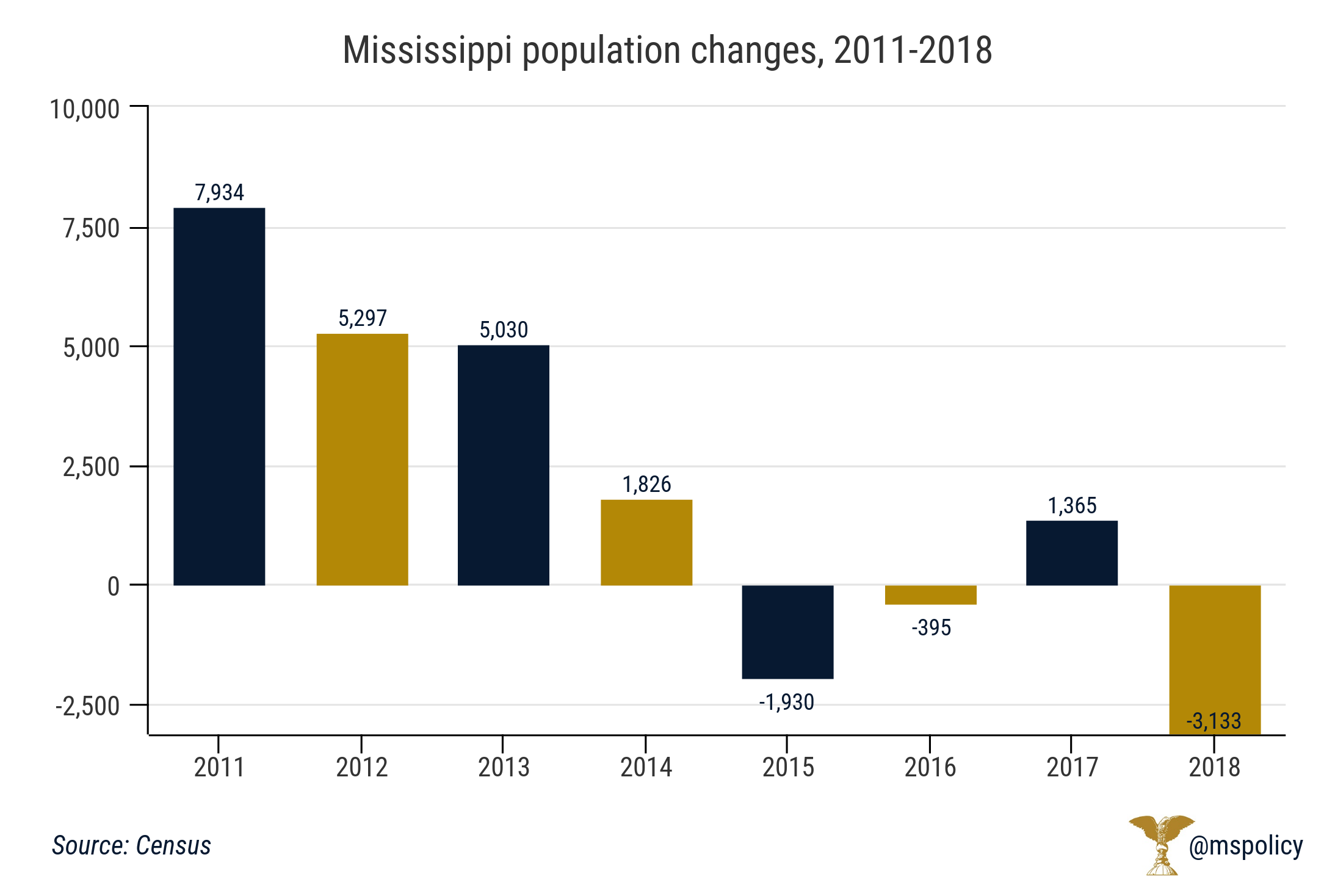
The 2018 population estimate is 2,986,530. Mississippi experienced a short population increase of more than 20,000 residents during the first half of the decade, but the population is now down more than 4,000 people since 2014.
Among other neighboring states, over the past year, the population in Alabama increased by 12,751, in Arkansas it increased by 10,828, and it increased by 61,216 in Tennessee.
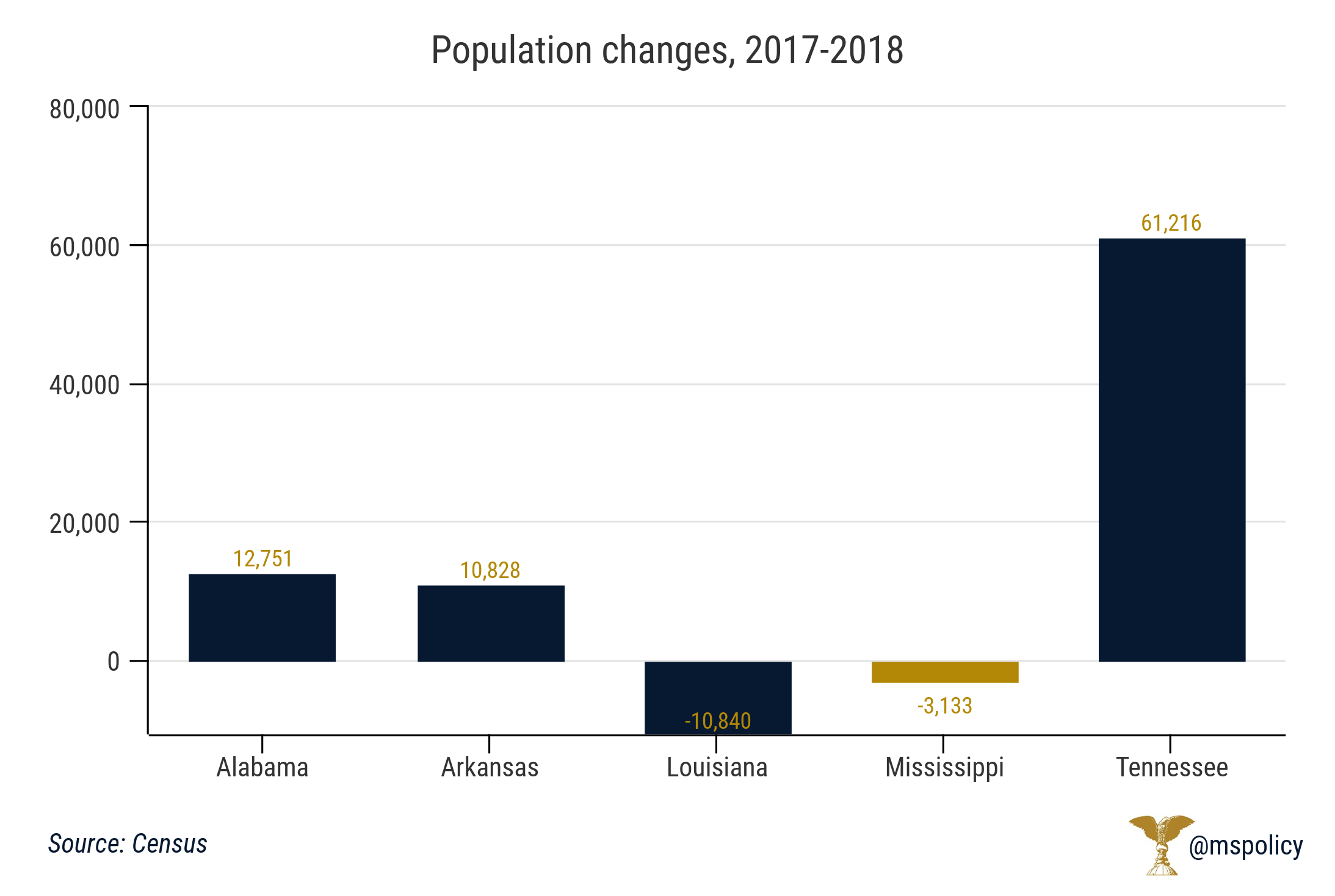
Tennessee’s population boom isn’t a surprise, or anything new. The state has added more than 400,000 residents since the 2010 Census.
And it’s part of a migration trend. People are leaving progressive income tax states and moving to income tax free states. Over the past year, 339,396 Americans moved to no income tax states, including Tennessee. And 292,947 left progressive income tax states.
Mississippians have among the highest tax burdens
As Census data shows, Mississippi’s tax burden is hurting the state. As a percentage of personal income, Mississippians have a state and local tax revenue rate of 10.57 percent. The national average is 10.08 and the Southeast average is 8.57.
Among neighboring states, Alabama has a rate of 8.23, Arkansas is 9.91, Louisiana is 9.22, and the income-tax free state of Tennessee is 7.76. This means Tennessee runs their government for about 25 percent cheaper than Mississippi. Mississippi is the only state in the Southeast, save for West Virginia, over 10 percent. The Mountaineer state is the highest in the region at 11.23.
Mississippi’s percentage has gone up steadily over the past few years. From 2010-2012, it ranged from 9.84 to 9.88. But this trend has, unfortunately, been going in the wrong direction.
If Mississippi would choose the economic liberty model of limited government and free markets, it would see income growth and poverty reduction.
In simple terms, we’ve advocated for a path to prosperity. That path is built from policies that favor capitalism, free enterprise, robust competition and consumer choice. We do not believe there is another path that leads to durable prosperity, including the path that requires government to involve itself heavily in the orchestration of the economy.
At the end of October, the Fraser Institute, a leading think tank and research institution, published the "Economic Freedom Report for North America." The report measures the degree to which the policies and institutions of states and countries are supportive of economic freedom. The cornerstones of economic freedom are personal choice, voluntary exchange, freedom to enter markets and compete, and security of the person and privately owned property. Forty-two data points are used to construct a summary index and to measure the degree of economic freedom. This report has been published every year since 1986 and is regarded globally as one of the most robust and reliable measurements of economic freedom. Mississippi again ranked in the bottom quartile this year. Among the other states joining Mississippi in that quartile were California, Oregon, Minnesota, New York and Vermont.
Mississippians have very little in common with any of these states. These states are not geographically, politically, historically, or culturally similar to the Magnolia State. In fact, about the only thing Mississippi has in common with these states is its lack of economic freedom.
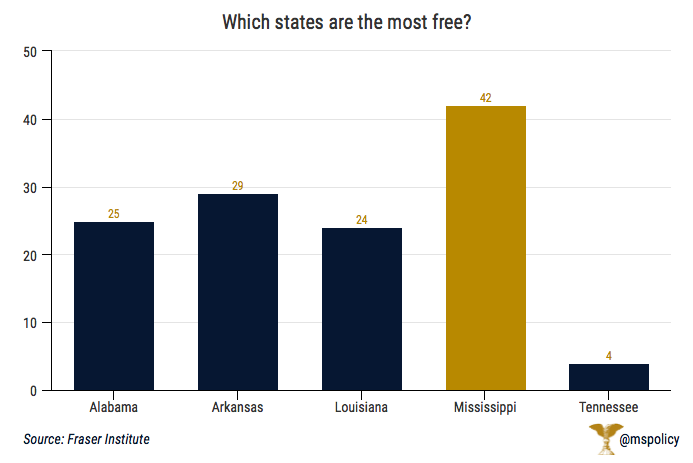
When we looked at the Fraser Index, which ranked Mississippi at #42 in 2018, we also noted that none of our neighbors were ranked as poorly. In fact, the average ranking for our contiguous neighbor states was #21 and no state ranked higher than #29. If you look to the 11 states making up the Southeast, from Virginia to Texas, the average ranking was 17.
Despite our advocacy for policies based on economic freedom, there remain leaders in Mississippi who seem unconvinced. There remain advocates for more and more reliance on the public sector. Many claim Mississippi is uniquely inoculated from experiencing economic growth and poverty reduction through the free market. Some even claim our lack of economic growth and poverty reduction is irrecoverably tied to our history or our geography. If only there was an example of a state that previously had similar economic freedom scores but embraced economic freedom polices over time and significantly improved the lives of its citizens as a result. If only we had data over the past twenty years than could show us how poverty can be reduced and per capita income can be increased in a state like Mississippi when freedom is the central public policy. Rather than one state, we’ve identified two states than serve as shining examples.
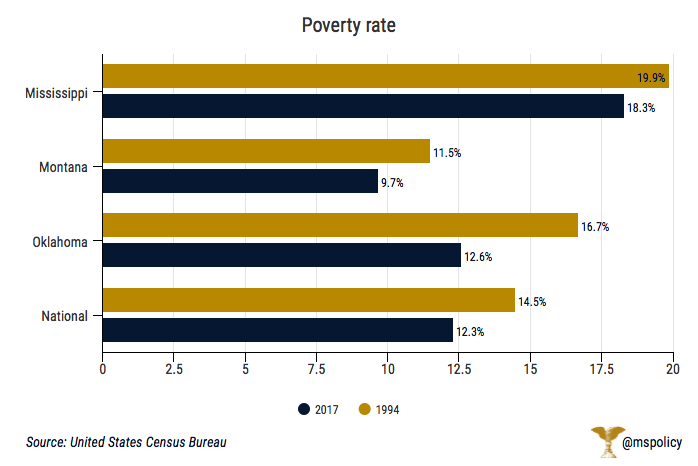
Let’s start by looking at the national poverty rate. In 1994, the rate was 14.5%. Today, the national average is 12.3%, a 15% reduction. In Mississippi in 1994, the poverty rate was 19.9%. Today, the rate is 18.3%, an 8% reduction. In Oklahoma in 1994, the poverty rate was 16.7%. Today, the rate is 12.6%, a 25% reduction. In Montana in 1994, the poverty rate was 11.5%. Today, the rate is 9.7%, a 16% reduction.
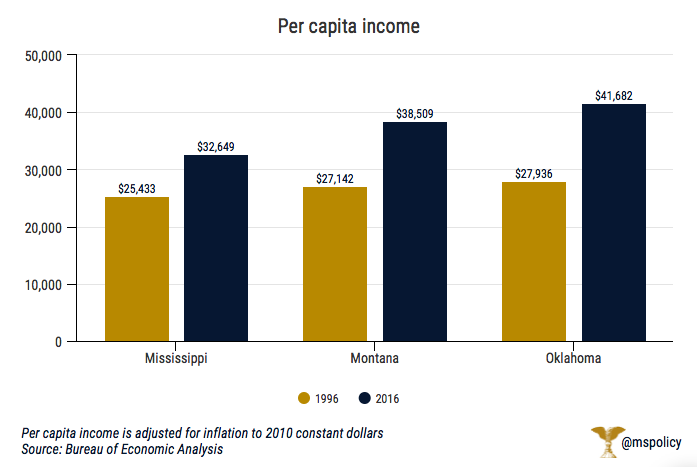
Next, let’s look at per capita income for the three states over a 20-year period. In 1996, the average income in all three states was very similar. In Mississippi, the average income was $25,433 (48thin the nation). Montana had an average income of $27,142 (46th) and Oklahoma $27,936 (45th). Twenty years later, Oklahoma had risen to 28thwith an average income of $41,682. Montana had risen to 38thwith an average income of $38,509. Over that same 20-year period, Mississippi slipped two sports to 50thplace with an average income of $32,649.
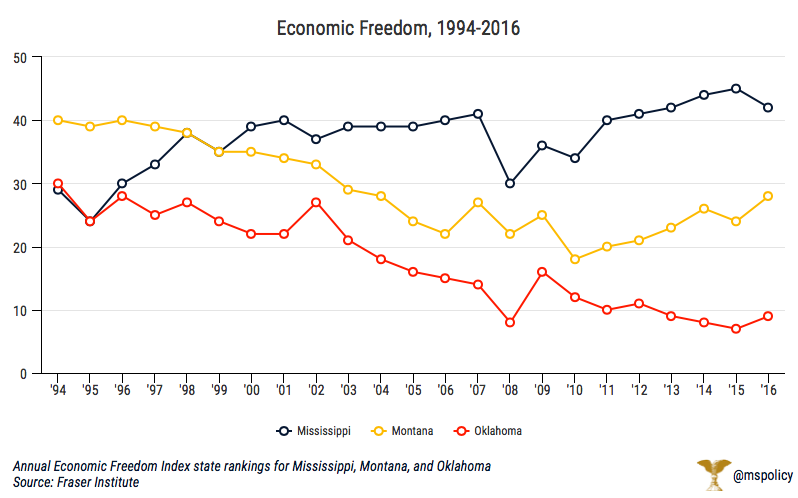
If we go back to the Fraser Institute Economic Freedom Index and plot how each of the three states performed in the same years (1994 to 2016), we see the strong correlation between economic freedom and prosperity. It is stark visual evidence of the power of choosing economic freedom. In 1994, Mississippi was ranked slightly more economically free than Oklahoma and considerably more so than Montana. Over the ensuing 22 years, Mississippi moved steadily away from economic freedom and the results are evident.
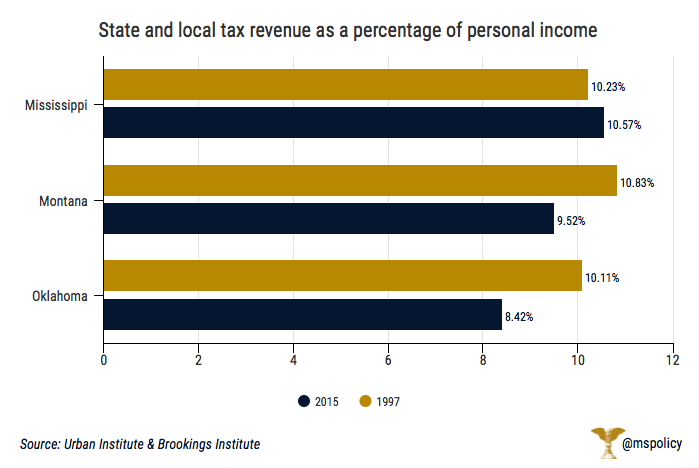
There is another valuable set of data that helps demonstrate the policy point as we compare Mississippi, Oklahoma and Montana. The Tax Policy Center, a joint project of the Urban Center and the Brookings Institute, publishes a report on state and local tax revenue as a percentage of personal income in each state. From 1997 to 2015, the tax burden in Oklahoma fell from 10.11 to 8.42. In Montana, the burden was reduced from 10.83 to 9.52. In Mississippi, the tax burden increased from 10.23 to 10.57. No other state in the Southeast had a burden at or above 10.0. At 10.57, Mississippi finds itself once again in the company of states like California, New York, New Jersey, Minnesota and Illinois.
What is the data and evidence telling us? It is informing us to choose capitalism and free markets. It’s telling us to move away from a “command and control” economic system and start relying more on individual freedom, consumer choice, and private competition. It’s telling us to allocate more resources towards free enterprise and fewer resources towards the political process. If we can start to get Mississippi’s economy growing by adopting policies that prioritize economic liberty, we can experience prosperity.
When states grow, other measures of quality of life are improved. Educational outcomes improve. Crime rates go down. Health measures improve and life expectancy expands. Montana and Oklahoma are real-life examples of how lives can be measurable improved when states make a commitment to economic freedom. They’ve shown us the road map. There is no reason Mississippi can’t take the road to freedom. All it takes is the will and strong leadership to take the first steps.
This column appeared in the Clarion Ledger on December 9, 2018.
Occupational licensing laws force Mississippians to spend time and money to receive permission from the government before they can earn a living.
This is a relatively new phenomenon. In the 1950s, just five percent of the workforce needed a license to legally work. At the time, occupational licensing was largely limited to medical professionals, lawyers, and teachers. However, as we often see when government is involved, license requirements have expanded dramatically.
Today, approximately 19 percent of Mississippians need a license to work. This includes everything from a shampooer, who must receive 1,500 clock hours of education, to a fire alarm installer, who must pay over $1,000 in fees. All totaled, there are 66 low-to-middle income occupations that are licensed in Mississippi.
As new licenses have been added to the books in Mississippi, it is safe to assume that each proponent, usually an occupational licensing board, made the same central argument. We must do this in the name of consumer safety to protect individual citizens. But the reality is often something less altruistic. Mainly, these occupational associations are more interested in building a moat around their industry with the help of government. The harder it is for someone to enter an industry, the less competition and consumer choice the industry incumbents face.
This may artificially raise the wages of industry practitioners by raising the prices of goods and services that require such licenses, but it does so by limiting options and increasing consumer costs. This will often have an outsized impact on low-income Mississippians, who then have to make otherwise unnecessary decisions on what they will or will not purchase.
Just this past year, the Mississippi legislature, with little discussion and few dissenting votes, passed a bill to make it more difficult to become a real estate broker. The proposed law sought to increase the time it would take to become a broker, going from the current one year to three years. Fortunately, Gov. Phil Bryant vetoed the legislation.
Who were the individuals supporting such legislation? Was it the Coalition of Mississippians Against Inexperienced Brokers? A group of citizens negatively impacted by brokers who had just one year of experience? No, it was, naturally, the Realtors Association.
But the bigger problem isn’t just one specific association pushing the legislature to limit competition, it is the cost of all unnecessary and burdensome regulations on Mississippi’s economy.
According to a new report from the Institute for Justice, Mississippi has lost 13,000 jobs because of occupational licensing and the state has suffered an economic value loss of $37 million. To put that into perspective, just by legislative action to rollback unnecessary licenses, we can create two Nissan plants…without spending a dime of taxpayer dollars.
Instead of relying on government, these are the actions that will encourage and promote economic growth in Mississippi. If that is our goal, we need to trust in the benefits of the free market and a “lighter touch” from government and occupational licensing regimes and we need to return to a belief in individual responsibility.
This can be achieved in a number of ways. For example, voluntary certification offers an avenue for reform. This already occurs in many industries and allows private third-parties to set standards for individuals to voluntary subscribe as one level of quality assurance.
One of the more widely recognized private certifications is the Automotive Service Excellence (ASE) certification for mechanics. You can open a garage tomorrow with – or without – the ASE certification and customers may or may not care.
But that decision is left to the entrepreneur and the customer, not to the government or the industry lobbyist or the board of licensure. We can do this with any number of professions currently licensed by the state. If we really want more jobs and fewer people dependent on government, it starts by creating an environment that encourages work; not one that encourages the creation of hurdles and obstacles.
This column appeared in the Madison County Journal on December 6, 2018.
Americans have always been a transient people, often searching for new careers and better opportunities for their family.
Depending on the economy of the day, we see 30 to 40 million Americans move each year. And when they move, they bring their incomes with them. Between 1995 and 2010, some $2 trillion in adjusted gross income went from one state to another.
As a result, some states brought in billions more in incomes over the past 25 years while others lost that amount and then some.
Mississippi lost $132 million in annual AGI. Looking more closely at the state, Desoto county was the big winner, gaining $1.34 billion in annual AGI, mostly all of it from across the border in Shelby county, Tennessee. Rankin ($523 million) and Madison ($912 million) counties were the other big beneficiaries of wealth transfers in the state, but that was mostly from Hinds county, which lost $1.55 billion in annual AGI.
Not surprisingly, the Delta, which is shedding population, also saw big loses in income. The five counties of Bolivar, Coahoma, Leflore, Sunflower, Washington lost between $100 million and $250 million. That wealth was generally lost to either the Jackson metro area or both sides of the Mississippi/ Tennessee state line. Throughout the state, we saw a few areas of growth (such as Lafayette county) or decline (such as Lauderdale and Lowndes counties), but most other places were more or less stagnant. Very little wealth gained, very little wealth lost. And it was usually just in-state transfers.
The only other counties to see wealth gained from out-of-state were Hancock and Pearl River counties, along the Louisiana border. They both gained between $180 and $200 million, mostly from Louisiana.
However, Louisiana stood out as having the biggest losses in the South. The state lost some $8 billion in annual AGI, with more than $500 million shifted toward Mississippi. Among other neighbors, Alabama saw a gain of $2.5 billion and Arkansas saw a gain of $2.6 billion. Tennessee gained over $14 billion - even with the big loses from Shelby county to Desoto county.
Overall, the states that did the best won’t surprise many people. Arizona gained $35 billion in annual AGI, Texas gained $47 billion, and Florida gained $156 billion. That was at the expense of many states, but three in particular lost between $50 and $100 billion each year. This includes Illinois, California, and New York, the biggest loser of all. The Empire State lost $100 billion in annual AGI.
But why? After all, it’s tough to compete with Chicago, New York, San Francisco, and Los Angeles.
Because the states that Americans are moving to, and where they bring their income along, are low and no tax states. Florida and Texas do not charge you for working, while Arizona has a relatively low individual income tax rate. Certainly better than California, though that isn’t saying much.
When New York Gov. Andrew Cuomo was being criticized from both the left and the right for offering between $1.5 and $2 billion in taxpayer incentives to Amazon, he defended the decision saying his state needs to offer incentives to compete with states that don’t have an income tax. If a governor has to say that, it should highlight the lack of competitiveness that state has, regardless of what else it has to offer.
When states have higher tax rates, that naturally allows the state to confiscate more money from taxpayers and gives them the ability to dole out money to their preferred companies. Rather than let the market work, you have selected interests who are insulated from higher taxes at the expense of everyone else.
We all seem to understand the not-so-secret, secret sauce. Low taxes and a light regulatory touch lead to job growth. Americans then move to where there is a combination of good jobs, high quality of life, and reasonable housing costs. And the state’s that are doing things right are the ones who benefit. In other words, prosperity is closely linked to freedom-based public policies. If we want to grow and provide more opportunities in Mississippi, then let’s take the path that makes it easy to start a job, open a business, earn a side income, invest capital, serve customers, compete with incumbent businesses, and keep more of what we earn.
Economic development, incentives via the government, and economic growth, based on free market principles, should not be confused.
Well-meaning public officials, government employees, community business owners and executives, and chamber of commerce cheerleaders have the best of intentions when they propose ideas for economic development. I believe they are genuinely trying to help. I just wish they would stop. When we confuse economic development with economic growth, we make big mistakes in public finance. These two concepts may sound similar but they are, in fact, opposites. An emphasis on one or the other leads to different results.
Those of us interested in seeing economic growth advocate for broad public policies like lower taxes, a reduction of the regulatory burden on businesses, the elimination of double taxation on investments and savings, and a reliable and predictable legal and regulatory environment. In stark contrast, proponents of economic development argue for subsidies, tax abatements, and regulatory relief for specific businesses or industry types in particular regions. The latter believe the economy can be directed by government involvement; the former believe the economy will produce a better outcome when we leave it to the entrepreneurs and consumers to determine the direction.
For those of us with a belief in the durable power of free-markets, the choice is easy. We know, thanks to Adam Smith and 242 years of data, wealth is created by the free exchange between producers and consumers. If we leave markets free and allow the natural incentive of profit-seeking to work, without government trying to influence, direct, guide, orchestrate, manage or nudge, the states maximize their economic growth. Such growth is what drives long-term employment and increased prosperity. When we replace the decisions of entrepreneurs, investors, and consumers in the private market with decisions of politicians, government officials and development boards, we significantly lower the odds of achieving economic growth.
Economic development policy really means the state picking the winners and losers by employing direct subsidies and tax breaks to attract or promote specific businesses or industries. An authentic effort to grow our economy would not focus on giving targeted companies the assistance and resources without providing those to all companies and industries. It is not fair to the current companies in Mississippi, who built their businesses without government help, to find themselves competing with companies subsidized by taxpayers. For too long, Mississippi has followed a policy that supposes “economic development” can be a meaningful driver of economic well-being in the state. It cannot. That policy is a losing one.
The evidence produced from analysis points convincingly to the conclusion that these targeted incentives do not produce long-term benefits in excess of their costs. In many cases, the cost-per-job is extraordinarily high. While some high-profile companies and their political allies may be better off, non-beneficiary companies may lose workers or experience wage increases, or both, and the state’s economic activity as a whole slows.
When political favor seeking is emphasized like this, it thwarts the private sector and tips the scales in favor of those companies and individuals with access to political relationships. It sends a message to the private sector that it should not focus on consumer-oriented actions, like product/service innovation or marketing, and focus resources instead on lobbying, legal representation, and elections. That’s not a recipe for sustained economic growth.
While economic development incentives, like those practiced by the Mississippi Development Authority, may lead to the creation of new jobs; that does not mean such jobs lead to the creation of economic growth. Measuring jobs alone is an insufficient way to measure economic growth. For example, roughly 90% of the Canton-based Nissan plant employees were already employed when that Madison County facility opened. Those new employees were already paying state income taxes. Yet, every job created by the state and local government incentive package was subsidized. In total, roughly $1.3 billion was promised to Nissan. According to data analyzed by Mississippi State University’s Institute for Market Studies, Nissan pays its 6,400 workers at the plant an average of $62,500, which costs taxpayers $203,125 per worker. Had that taxpayer subsidy not occurred and the dollars remained in the private sector, would individuals and businesses have found a better “investment” use? Decades of economic research and free market evidence informs us that private citizens and firms are more effective at allocating resources to their highest uses than is government.
The chief argument around government incentives is that “everyone else is doing it, so we must join the process in order to remain competitive.” That’s the wrong approach. The desire to provide incentives is an acknowledgment that our tax, regulatory, and legal system is not competitive. It says our state has not adopted freedom-based policies. Instead of offering incentives to just a few, our goal should be to create the most business-friendly climate in the country. A public policy based on freedom is how we’ll grow our economy.
Rather than increase the hand of government in our economy, we should trust the “invisible hand” of the market place and the proven incentive of profit and loss for the allocation of resources. It is either folly or hubris to think government can have the knowledge to do that more efficiently than the market. Nobel Prize-winning economist F.A. Hayek once wrote, “The curious task of economics is to demonstrate to men how little they really know about what they imagine they can design.”
This column appeared in the Clarion Ledger on November 2, 2018.
Few people would argue with the beauty of a California sunset. The bright lights of Times Square are tough to compete with. But there is one thing that can top the allure of California or Manhattan: your pocketbook.
While many on the left may argue that a certain class of Americans enjoy the high-tax, high-regulation burdens of our most liberal cities and states, and the perceived protections that go with it, the numbers paint a different picture.
Americans are moving to lower tax states where they are able to keep more of the money they earn. This isn’t a talking point, but a statistical reality based on migration data. Unfortunately, Mississippi is on the wrong side of both taxes and, as a result, in-migration.
Sales, property, and individual income taxes, as a percentage of personal income in Mississippi, are 9.9 percent, according to Cato Institute. That’s pretty high. In fact, only 14 states, including traditional high tax states like California, Connecticut, New Jersey, and New York, fared worse. All neighboring states had lower tax burdens than Mississippi. What effect does this have?
Mississippi had a net migration loss of over 3,500 in 2016. On a per capita basis, this means Mississippi lost 100 residents for every 88 the state gained. This is parallel with migration loses in Louisiana. Alabama and Arkansas were essentially flat in terms of migration while Tennessee added over 13,000 residents. For every 100 residents that Tennessee lost, they added 119.
Tennessee, a state without an individual income tax, is home to one of the lowest tax rates in the country with a tax burden of 6.5 percent. And they are reaping the benefits of smart fiscal policy. The Wall Street Journal reported in May: “Alliance-Bernstein Holding LP plans to relocate its headquarters, chief executive and most of its New York staff to Nashville, Tenn., in an attempt to cut costs…In a memo to employees, Alliance-Bernstein cited lower state, city and property taxes compared with the New York metropolitan area among the reasons for the relocation. Nashville’s affordable cost of living, shorter commutes and ability to draw talent were other factors.”
Twenty-six states had a tax burden of 8.5 percent or greater. Of those 26, 25 had a net out-migration. Only Maine was able to buck the trend. And not surprisingly, of the 17 states that had net migration gains in 2016, all but one has a tax burden of less than 8.5 percent. All totaled, more than 500,000 individuals moved from the top 25 highest-tax states to the 25 lowest-tax states in 2016. Those high tax states lost an aggregate income of $33 billion.
Along with the relatively high individual tax burden, our business tax climate sits at 31st best, according to the Tax Foundation. Not terrible, and actually better than Alabama, Arkansas, and Louisiana, but not great either. The same report had Tennessee at 16.
So what can we do in Mississippi? We can follow the lead of high-growth, low-tax states in the Southeast that have lower taxes, lighter licensure and regulatory burdens, and a smaller government.
This past session, the legislature debated a bill known as the “Brain Drain” Tax Credit. It would have provided a three-year income-tax exemption to recent college graduates who are Mississippi residents. And there was an additional two-year exemption for those who start a business. It passed the House unanimously but died in the Senate without a vote.
States are in competition with one another. We know this because we routinely offer incentives for select companies in the form of subsidies or tax breaks, or we propose eliminating the individual income tax for three to five years for recent college graduates.
While we are always in favor of lower taxes, these moves are just an acknowledgement that our tax burden hurts individual opportunity and the state’s economic growth. We have succeeded in phasing out the lowest income tax bracket. Instead of eliminating the income tax for just a few, we should work on eliminating the income tax for all taxpayers. And instead of offering incentives to just a few, our goal should be to create the most business-friendly climate in the country – for all types, sizes, and industries.
A public policy based on freedom is the recipe high-growth states have adopted. It’s how we’ll grow our economy in Mississippi, too.
This column appeared in the Daily Leader on October 31, 2018.
